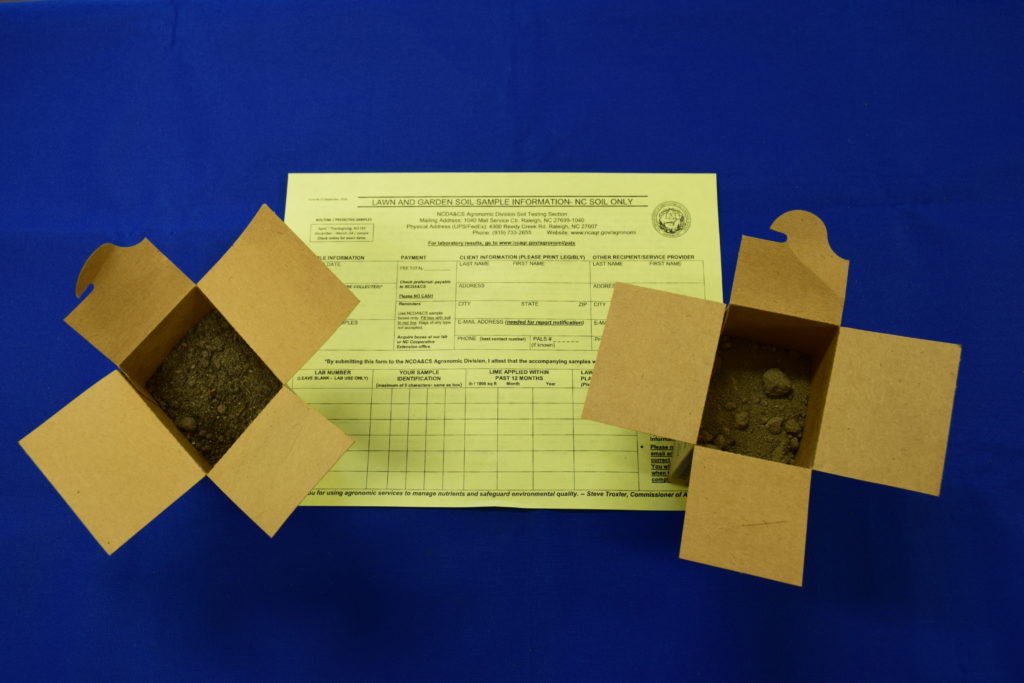Collect Soil Samples Now to Prepare for Next Year
go.ncsu.edu/readext?728023
en Español / em Português
El inglés es el idioma de control de esta página. En la medida en que haya algún conflicto entre la traducción al inglés y la traducción, el inglés prevalece.
Al hacer clic en el enlace de traducción se activa un servicio de traducción gratuito para convertir la página al español. Al igual que con cualquier traducción por Internet, la conversión no es sensible al contexto y puede que no traduzca el texto en su significado original. NC State Extension no garantiza la exactitud del texto traducido. Por favor, tenga en cuenta que algunas aplicaciones y/o servicios pueden no funcionar como se espera cuando se traducen.
Português
Inglês é o idioma de controle desta página. Na medida que haja algum conflito entre o texto original em Inglês e a tradução, o Inglês prevalece.
Ao clicar no link de tradução, um serviço gratuito de tradução será ativado para converter a página para o Português. Como em qualquer tradução pela internet, a conversão não é sensivel ao contexto e pode não ocorrer a tradução para o significado orginal. O serviço de Extensão da Carolina do Norte (NC State Extension) não garante a exatidão do texto traduzido. Por favor, observe que algumas funções ou serviços podem não funcionar como esperado após a tradução.
English
English is the controlling language of this page. To the extent there is any conflict between the English text and the translation, English controls.
Clicking on the translation link activates a free translation service to convert the page to Spanish. As with any Internet translation, the conversion is not context-sensitive and may not translate the text to its original meaning. NC State Extension does not guarantee the accuracy of the translated text. Please note that some applications and/or services may not function as expected when translated.
Collapse ▲Now is the time to start planning for next year’s garden. The first step in those plans should include getting a soil test now so that you can have your soil prepared and amended by the time spring is here.
Now is also a good time to get a soil test while they are free, before the peak-season soil testing fee starts. The soil test fee will start after the Thanksgiving holiday, continue through March, and will be $4 per sample.
A soil test is offered by the North Carolina Department of Agriculture and Consumer Services. A soil test allows you to learn about the soil pH and fertility of your soil. Boxes and forms are available at the N.C. Cooperative Extension of Wayne County office (3114B Wayne Memorial Drive, Goldsboro). After you submit a soil sample, you will receive a report a few weeks later. The report will let you know important things about your soil, like pH and nutrient levels. The report will give you fertilizer and lime recommendations needed to reach optimum soil conditions.
Turnaround time on soil test results can vary from 3 to 6 weeks. If you are considering sending off a soil test, now would be a good time so you can have your results to start planning for next year’s garden.
When you collect a soil sample, there are a few things to keep in mind to get the best results. As you prepare for collecting samples, you want to consider how many separate samples should be collected. You want to collect samples based on what types of plants you are growing. On the form, you will indicate the types of plants you are growing so recommendations will be tailored for those plants. For example, you may collect separate samples for your vegetable garden, lawn, and flower beds. Another aspect to consider when deciding how many samples to collect is to look at areas that may vary in soils type or drainage. If you were going to collect a sample for your lawn, you would probably want to collect separate samples for the front and back lawn. You will want to also collect separate samples for acid-loving plants like centipede grass, blueberries, and azaleas. These plants prefer soils to be more acidic (lower soil pH) than other plants.
As you collect a sample, you want to collect several (6 to 10) “mini-samples” randomly within the area. Then mix the samples in a bucket before putting in the box that will be sent for testing. This method will provide a better representation of the entire area and lead to better results.
Once you receive your results, you will be provided with lots of information about soil pH, phosphorus, potassium, lime, and fertilizer recommendations. Sometimes this information can be overwhelming or confusing. The N.C. Cooperative Extension of Wayne County office can assist people with understanding their soil test results and determine if amendments are needed to the soil.
Jessica Strickland is an Agriculture Extension Agent, specializing in horticulture for North Carolina Cooperative Extension in Wayne County.
Learn More!
- Sign up for the Wayne County Extension Gardening email list to receive timely gardening tips.
- Learn more by following us on Facebook and Instagram





